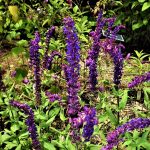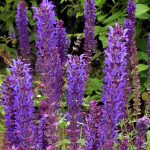Salvia nemorosa varieties: are all herbaceous perennials, approx 40-60cmH. Winter dormant, with combinations of purple, pink, mauve flowers in spring through to summer.
Salvia nemorosa varieties include:
‘Amethyst’
‘Caradonna’
East Friesland / Ostfriesland
‘Kate Glen’
‘Lambley Dumble’
ssp ‘Tesquicola’
Flowers: Colours can vary between, pale pinks, mauves, occasionally blues, purples and everything in between.
Flowers are all a small falcate type, with either a straight or curved hood. The 2 side lobes are small, either curved back to open the throat area or are sticking upwards. The middle lobe is large and mostly cupped to hold a drop of moisture for insects; this also acts as a landing place for any pollinating insects.
Most flowers have some markings or pale area around the throat area to act as a beeline to guide the insects further into the corolla.
All varieties are bee or insect pollinated and come in a variety of colours, accentuated by the colour of their calyces and bracts.
Inflorescences or flower stems are usually spikes of which there are quite a few to each plant. Each spike may reach anywhere between 20-30cm or even 60cm for the taller varieties.
Flowers are held in whorls of 4 flowers, evenly spaced , but tightly packed along the stem. Most of the stem being made up of flowers, which begin in mid spring, continuing throughout summer and may extend into autumn. These are a magnet for bees and insects.
Calyces: are small, ribbed with pointed lobes. Most calyces are usually 1 colour with the ribs being another colour, giving another colour dimension to the whole flower. A short wide coloured bract usually falls off when the flower opens, but may remain in one or two varieties. Calyces remain on the stem after the flower has finished even if not pollinated.
Leaves: are usually narrow and long, some a bit wider than others, most have a pointed apex, but some are slightly rounded. The midribs are mainly seen, with other veins being very small. Most have small petioles, some longer than others.
Both the top and beneath are more or less the same colour which may vary slightly, some have a blue hue, some a slight green/grey hue and others a little darker. The texture is usually smooth, but may be a bit leathery occasionally slightly hairy and all have small crenations around the leaf edge.
As these varieties originate in Europe where they have a short summer season, when they emerge in the spring, they begin sending up flower spikes fairly soon after the leaves have formed into a rosette of basal growth.
The leaves that form up the flower spike are sessile ( no petiole), long and narrow, becoming smaller as they ascend up towards the flowers appear.
Some Salvia nemorosa varieties are often confused with Salvia x sylvestris which a cross between S. pratensis ( Meadow Sage) and S. nemorosa (Wood Sage) These include:
S.x sylvestris ‘Lubecca’
S.x sylvestris ‘Tanzerin’
As these plants are all herbaceous, coming from a short season, they like to send up their numerous spikes in mid to late spring. To get the best from these plants, they like an open sunny position to keep their flowers growing straight upwards. This allows the insects easy access to the flowers.
They are best planted in groups of 3 or 5 plants, either in a group or a lineal row to get the best impact. Being fairly small these plants are an ideal plant for a long border, or in groups within a mixed border. With all those flower spikes they certainly put on a magnificent show and can be spotted anywhere within a garden.
Pruning / cutting down. see Lambley Nursery’s time of cutting down advise.
After the flowers have finished in late summer or autumn, cut down the flowering stems, clear away any debris and mulch to keep the crown warm over the winter months.
Just before the leaves emerge, feed well and top up the mulch to keep the root area cool over the hot summer season.
Propagation: usually from seed or division in autumn.
Back to Varieties









